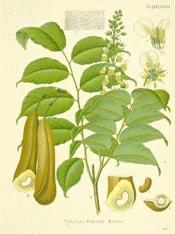
Botanical.com Home Page

|
Balsam of Peru
(Myroxylon balsamum)
Click on graphic for larger image
|
Balsam of Peru
Botanical: Myroxylon Pereiræ (KLOTSCH)
Family: N.O. Leguminosae
---Synonyms---Toluifera Pereira. Myrosperum Pereira.
---Part Used---Oleoresinous liquid.
---Habitat---Central America in the forests of San Salvado.
---Description---A large and beautiful tree with a valuable wood like mahogany, and a straight smooth trunk; the last is coarse grey, compact, heavy granulated and a pale straw colour, containing a resin which changes from citron to dark brown; smell and taste balsamic and aromatic. Leaves alternately, abruptly pinnate, leaflets two pairs mostly opposite, ovate, lanceolate with the end blunt emarginate; every part of the tree including the leaves abounds in a resinous juice. The mesocarp of the fruit is fibrous, and the balsamic juice which is abundant is contained in two distinct receptacles, one on each side. The beans contain Coumarin, the husks an extremely acrid bitter resin, and a volatile oil; a gum resin, quite distinct from the proper balsam, exudes from the trunk of the tree and contains gum resin and a volatile oil; the tree commences to be productive after five or six years, and continues to yield for thirty years; the flower has a fragrance which can be smelt a hundred yards away.
The process of extraction produces three grades of balsam; the title 'Balsam of Peru' is derived from the fact of its being shipped from Peru. There are several fictitious Peruvian balsams found in commerce, but they do not contain the same properties. A white balsam is made from the fruit of Myroxylon Peruviatta or Pereiræ, which has a peculiar resinous body and none of the chemical constituents of Balsam of Peru; this is termed Myroxocarpin. Another substance obtained from the same tree and much used in Central America is termed Balsamito, it is an alcoholic extract of the young fruit. This is used as a stimulant, diuretic, anthelmintic and external application to gangrenous ulcers and to remove freckles. Balsam of Peru is warm and aromatic, much hotter and more stimulating than Balsam of Copaiba and is used for similar complaints. It is specially useful for rheumatic pains and chronic coughs.
---Constituents---A colourless, aromatic, oily liquid, termed cinnamein, dark resin peruviol, small quantity of vanillin and cinnamic acid.
[Top]
---Medicinal Action and Uses---Stimulant, expectorant, parasiticide. Used in scabies and skin diseases; it destroys the itch acarus and its eggs, and is much to be preferred to sulphur ointment, also of value in prurigo, pruritis and in later stages of acute eczema. It is a good antiseptic expectorant and a stimulant to the heart, increasing blood pressure; its action resembles benzoic acid. It is applied externally to sore nipples and discharges from the ear. Given internally, it lessens mucous secretions, and is of value in bronchorrhoea gleet, leucorrhoea and chronic bronchitis, and asthma. It is also used in soap manufacturing, for its fragrance, and because it makes a soft creamy lather, useful for chapped hands. Balsam of Peru can be applied alone or as an ointment made by melting it with an equal weight of tallow.
---Dose---10 to 30 drops, best given in syrup, with the yolk of an egg added, or with gumarabic.
---Adulterations---Castor oil, Copaiba, Canada turpentine, etc.
---Other Species---
MYROXYLON FRUTESCENS
---Habitat---Trinidad.
The pod is used in the island as a carminative, and externally in the form of a tincture. As a lotion for rheumatic pains, the stems yield a balsamic juice.
GUINA-GUINA
---Habitat---Paraguay.
This bark is used in powder and in decoction for wounds and ulcers, and the dried concrete juice of the trunk of the tree IS very similar to Balsam of Peru.
[Top]
Common Name Index
A MODERN HERBAL Home Page
Bear in mind "A Modern Herbal" was written with the conventional wisdom of the early 1900's. This should be taken into account as some of the information may now be considered inaccurate, or not in accordance with modern medicine.
© Copyright Protected 1995-2024 Botanical.com
|

